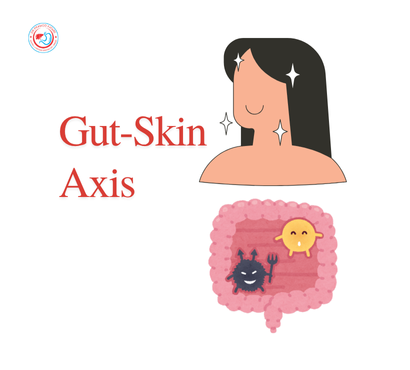1 | Understanding the Gut–Skin Axis
The gut–skin axis refers to the two-way relationship between our digestive system and our skin. A healthy gut microbiome supports:
- Balanced immunity
- Reduced systemic inflammation
- Protection of skin barrier integrity
Conversely, gut dysbiosis—microbial imbalance—can manifest as acne, eczema, rosacea, and premature aging. Researchers have identified pathways where metabolites, inflammatory molecules, and nerves link gut health to skin response.
2 | Mechanisms in Detail
A. Immune Modulation
Gut-“primed” immune cells migrate to the skin, altering inflammation and barrier strength.
B. Microbial Metabolites
Beneficial gut bacteria produce short‑chain fatty acids (SCFAs) that reduce skin inflammation and oxidative stress.
C. Neuroendocrine Signals
Stress alters gut flora, raising gut permeability (“leaky gut”) and allowing inflammatory molecules into circulation, worsening skin issues.
D. Hormones & Metabolic Health
Insulin resistance and metabolic imbalance can exacerbate acne and skin inflammation—often rooted in gut dysbiosis.
3 | Common Skin Conditions Linked to Gut Health
- Acne – Dysbiosis elevates sebum and inflammatory markers; improved gut flora eases flare-ups.
- Eczema / Atopic Dermatitis – Linked to low microbial diversity; SCFA-producing strains may restore skin defense.
- Psoriasis & Rosacea – Associated with gut permeability and bacterial toxin spread.
- Premature skin aging – Systemic inflammation accelerates collagen breakdown and dryness.
4 | Strategies to Strengthen Your Gut–Skin Axis
A. Eat Gut-Supportive Whole Foods
- High fiber from pulses, millets, oats
- Fermented eats: curd, idli, dosa, kanji
- Antioxidant-rich fruits, leafy greens, turmeric
- Omega‑3: flaxseeds, chia, walnuts
B. Use Probiotics & Prebiotics
Natural: curd, fermented vegetables
Supplements: Lactobacillus, Bifidobacterium strains
Daily intake supports microbial balance.
C. Avoid Triggers
Cut down refined sugars, processed foods, excessive alcohol—they drive dysbiosis and inflammation.
D. Stress & Sleep Hygiene
Regular sleep, meditation, and activities like yoga modulate gut and skin health.
E. Hydrate & Move
Adequate water and regular exercise aid digestion, circulation, and skin renewal.
F. Targeted Gut Healing
Post-antibiotics or illness, restore with fermented foods and fiber to reinforce gut resilience.
5 | Sample Indian Gut–Skin Diet Plan
| Meal | Food Suggestions |
| Breakfast | Oat porridge + chopped guava/berries + flaxseeds |
| Mid-morn | Curd smoothie with banana and turmeric |
| Lunch | Millet roti + dal + mixed seasonal veg sabzi + curd/raita |
| Evening | Green tea + roasted chickpeas seeds |
| Dinner | Brown rice + sprouts curry + sautéed greens |
| Bedtime | Warm turmeric milk with a pinch of black pepper |
Supplements: probiotic capsule (Lactobacillus + Bifido), omega‑3 (flax/chia), vitamin D.
6 | Timeline & Monitoring
- Effects on gut diversity: ~2–4 weeks
- Skin improvements often observed in 6–12 weeks
- Take photos, note symptoms, and track digestion to measure progress.
Skin health is deeply connected to gut function. By adopting a gut-friendly Indian diet—rich in fiber, fermented foods, healthy fats—and incorporating stress relief and hydration, you can strengthen your gut–skin axis and support a clearer complexion, improved barrier function, and long-term glow.
FAQs
Q1. Can probiotics alone cure acne or eczema?
No—probiotics help restore microbial balance and reduce inflammation but work best combined with diet, stress management, hydration, and skincare.
Q2. Any foods worsen gut–skin health?
Highly processed foods, sugary drinks, and excessive dairy can disrupt gut microbiome and spike inflammation—best to limit them.
Q3. How long to maintain this regimen?
At least 3–6 months; benefits accumulate over time. Many shift to a balanced maintenance eating pattern afterward.


